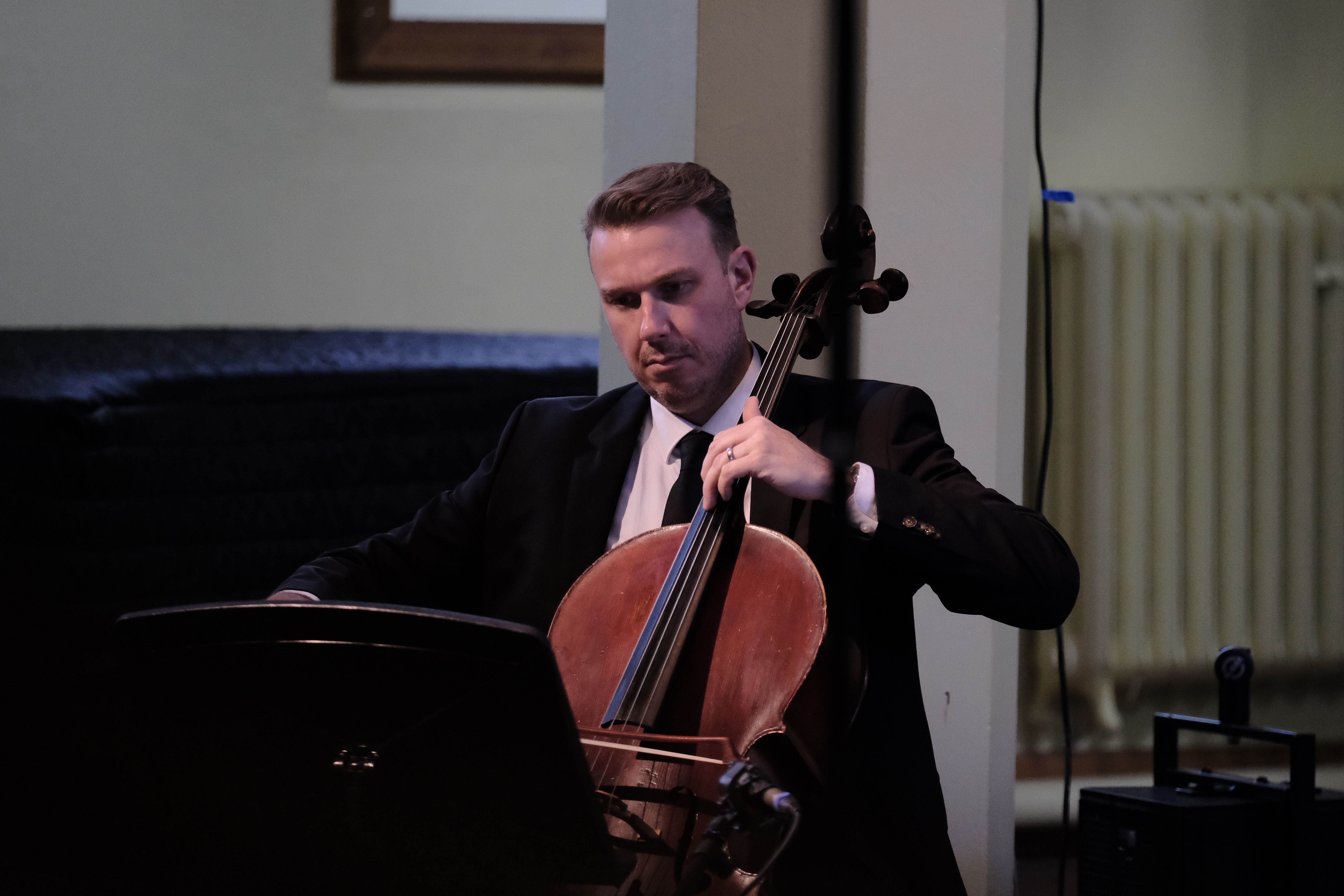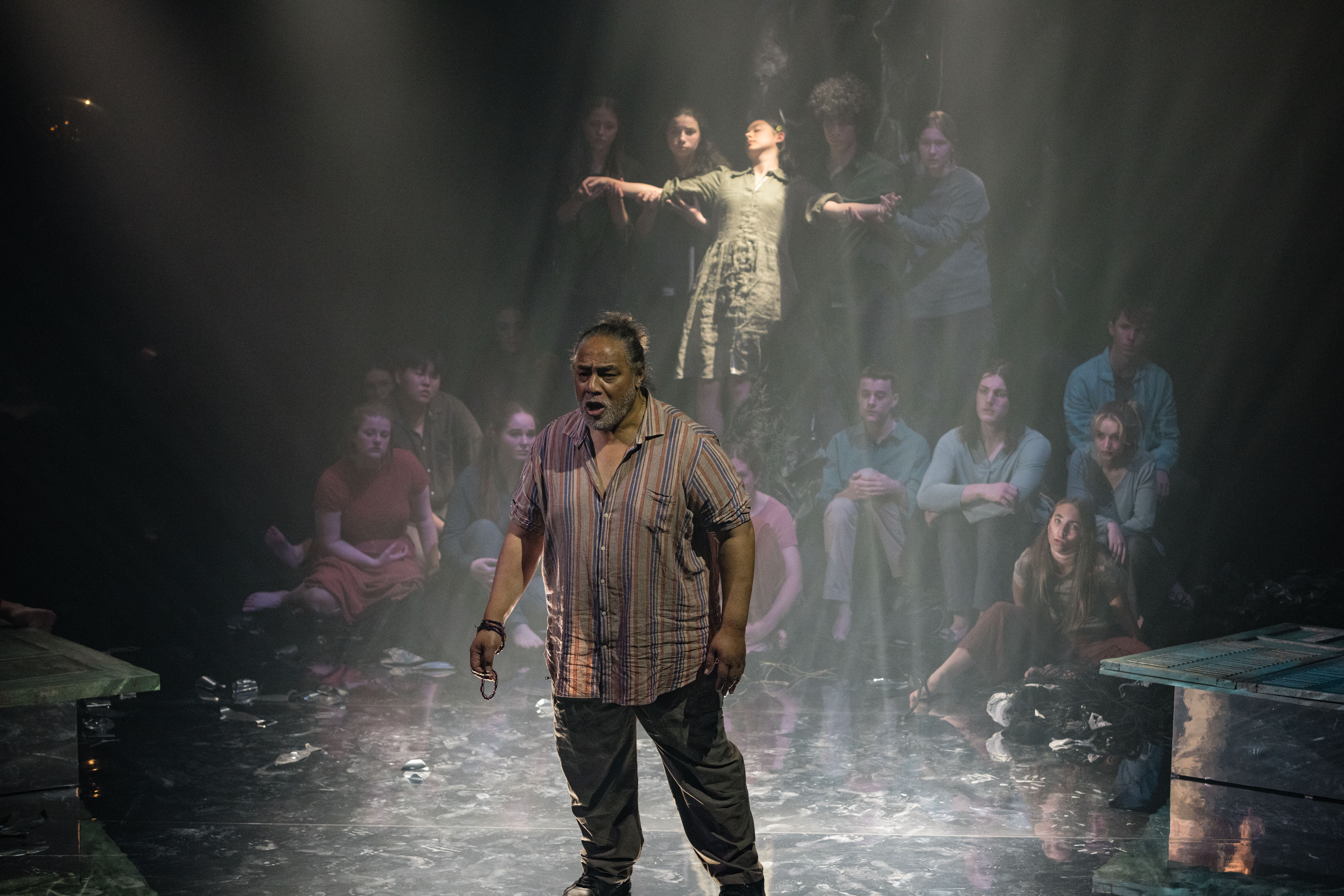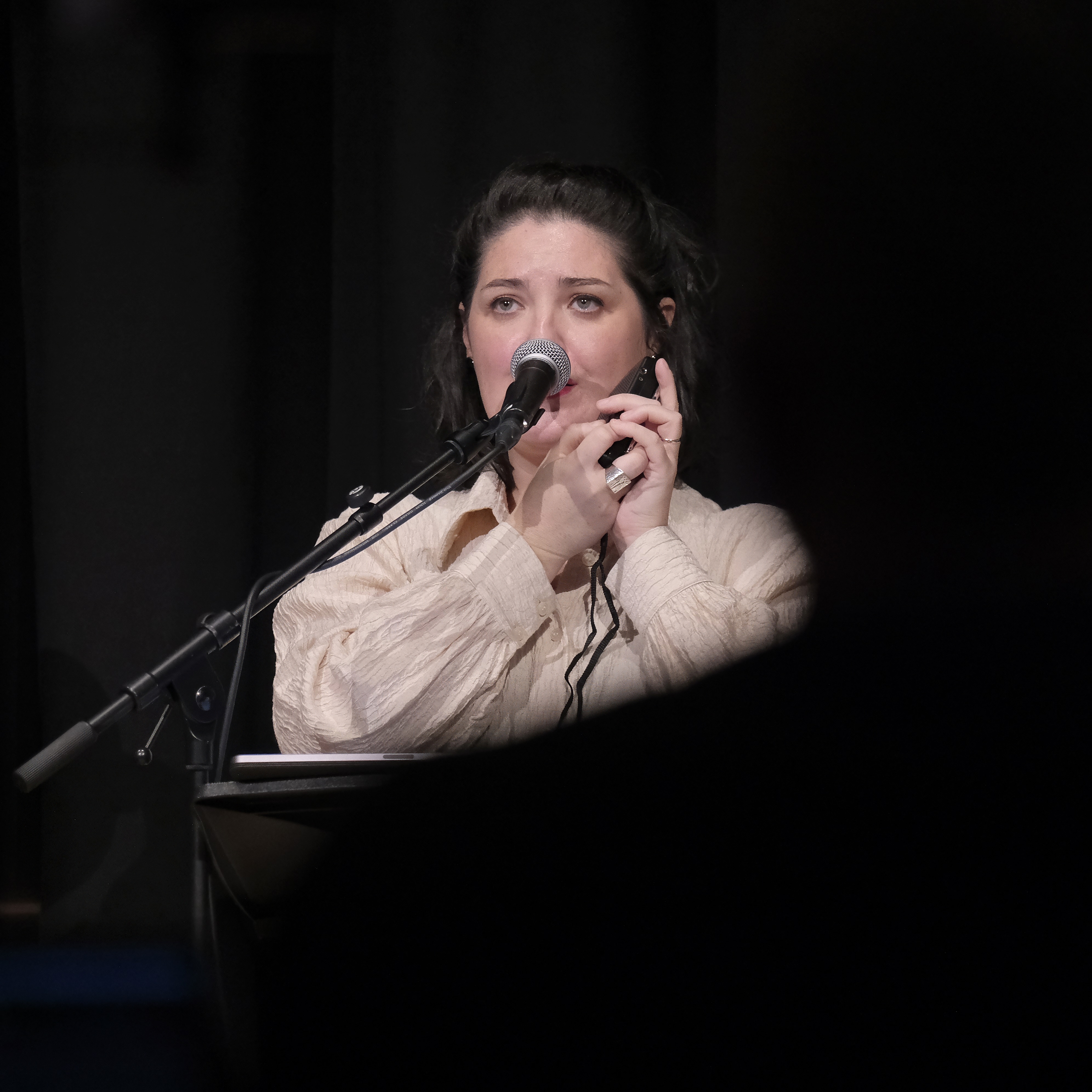26 September 2023
Review: Three Marys
 Image: Jessica O’Donoghue as Magdalena
Image: Jessica O’Donoghue as Magdalena © Matthew Duchesne
As I begin writing this review, one that is based on a detailed reading of the score, an online interview with the composer, background research and a private video viewing of a performance, I am struck by the terrible irony of its relevance: a day or so ago forty-one people were drowned off the coast of Lampedusa in their attempt to cross from Tunisia to Italy by boat. There were only four survivors.
How poignant then to know that the character Marzoug a fisherman who keeps watch for the sea's exiles, is inspired by Chamseddine Marzoug, a Tunisian fisherman who to this day carefully buries the dead washed up on the south coast of the mainland.
Exile and refuge-seeking find their contemporary parallel in this original work, inspired by a medieval legend: the Three Marys escaped persecution by sailing from Judea to Saintes-Maries-de-la-Mer, where to this day a church is dedicated to their memory.
In the opera they are identified as Maria, Magdalena and Sarah-Marie. Played respectively by Heru Pinkasova, Jessica O'Donoghue and Samantha Hargreaves, they represent three generations of women confronted with different personal histories that emerge during the course of a perilous journey, their stories echoing curiously with contemporary equivalents.
Whereas Maria remains faithful to her religion and believes in re-incarnation, Magdalena is sceptical. Sarah-Marie reflects a spiritual aspect in her other-worldly connection with the spirits of the Chorus, who symbolize children lost at sea. Indeed, it is the powerful embodiment of the youngest character by Hargreaves that convincingly manages emotional transitions such as from fear to grief to wonder or joy as the narrative unfolds.
 Another strong presence
is reflected in Marzoug, the watchman, played by Eddie
Muliaumaseali'i. Symbolising a link between the Chorus and the
main protagonists, his voice is vital in connecting both physical
and spiritual energies that circulate throughout the story.
Another strong presence
is reflected in Marzoug, the watchman, played by Eddie
Muliaumaseali'i. Symbolising a link between the Chorus and the
main protagonists, his voice is vital in connecting both physical
and spiritual energies that circulate throughout the story.
A teenage Chorus of sixteen mixed gender voices weaves its way around each scene alternately carrying the narrative forward or commenting, much in the tradition of a Greek Chorus but with the difference of real integration into the action itself. Echoes of French and Arabic are intoned after English to allow emphasis to the semantic meaning of the storyline and to remind us of historical, cultural connections to the legend itself. The choral vocalist Charbel Moussa adds a highly effective timbral colour to the layers of vocal sound in his distinctive style of chanting.
Many aspects of the Chorus' staging, choreography and lighting evoke biblical formations reminiscent of Renaissance painting and sculpture by artists such as Michelangelo, Raphael, da Vinci and Caravaggio.
Left: Samantha Hargreaves as Sarah Marie in Three Marys. Photo: Matthew Duchesne.

Distinctive colours of brown, yellow, beige and blue combine with bare arms and legs in tableau-like poses. Reflected in the glass 'floor' of the sea, they expose the vulnerability of human flesh. During the storm scene they embody the movement of fierce waves sweeping objects away from the small raft of the three protagonists. At other moments they become part of a tower-like structure full of the sea's debris, entering and exiting from its depths; this offers an effective vertical formation in contrast to the horizontal plane of the soloists' platform. Essentially their role remains that of an onstage audience who witness events but are invisible to the protagonists.

Turning to the role of the live instrumental ensemble, it is refreshing to view such proximity to the action onstage compared to the traditional allocation of an orchestra pit. Situated to the left behind the three soloists, eight musicians and their conductor, Simon Kenway, are sensitively lit at key moments, emphasizing their integral part in the opera on both a visual and an aural level. Indeed, their part is confirmed by a natural choreography of movement, one that reflects both the way in which each plays their instrument at certain points and how they connect with the action onstage. We witness a kinetic and emotional response to events happening nearby as they watch and listen, one that has been made possible by an exchange of performance energy between singers and musicians. By including the latter in the staging of the opera an interesting counterpoint occurs on both aural and visual levels between the vocal and instrumental lines on the one hand, and physical movements of the soloists/instrumentalists on the other.
With reference to the video filming of the last night by a team from Sydney Opera House, much care has been taken to focus on a particular instrumentalist, such as the violinist or the tuba player, at moments of sonic intensity. We witness the origin of a melodic line or a low bass note that continue the driving force of the music and lead it towards some kind of resolution. This is particularly the case with the violin, reflecting its expressive voice and similar tessitura to those of the characters Magdalena or Sarah-Marie. Emotional intensity is brought to a peak in Scene 10, Come Back, where Magdalena dives into the sea looking for her lost daughter. The string writing shivers, wind and percussion tremble, there is tremendous urgency in the ensemble writing, drawing the listener into a viscerally ferocious and menacing sound world.
Turning to the compositional approach outlined by Andrée Greenwell in her previous interview with Resonate, I am struck by her imaginative use of extended vocal and instrumental techniques. At the opening of the opera even the oud, a traditional Middle Eastern plucked instrument, is included, along with other bowed stringed instruments, in sliding between slow-moving glissandi harmonics, a technique achieved by the instrumentalist using the side of his pick. The Chorus not only sings but speaks, shouts, hisses, whispers, intones and cries. Such extensions of sound colour are woven into a traditional operatic form comprising styles such as post-minimalism, Baroque opera, and popular music cultures. The Recitative and Aria, for example, are expanded by this use of timbre, whilst at the same time ensuring an exposition of narrative.
There are influences of Stravinsky in the composer's use of blocks of colour, of Ravel, Satie and contemporary musicians such as Nick Cave. However, above all, the narrative impulse remains determined through the voice. An outstanding feature of this work is the use of audio design within its sonic fabric, resulting in very specific timbres that blend with both instrumental and vocal sources. Electronic instruments such as the synthesiser have been used in earlier works by the composer, who acknowledges the influence of Laurie Anderson in her approach. Greenwell applies a cinematic sonic impulse - from previous studies of sound design at the Australian Film Television and Radio School - to changes in a sound's spatial distribution as an extended compositional technique in itself. Synthesiser modulations are used live throughout a performance of the opera; these take the form of creative electronic interjections generated, in turn, by complex samples that have been previously written by the composer and are introduced each time by the keyboard player.
At key moments in the score there are indications to either instrumentalists or vocalists to improvise on the material, notated both graphically and / or with written instructions. In Scene 8, Fish Miracle, the Chorus breaks into multiple soloists improvising in the style of an incantation as they call on the fisherman Marzoug to save the protagonists from starving. Here the timbres of English, French and Arabic are heard in freely echoed repetition. Another instance occurs in Scene 9, Bridge of Moonlight: as Sarah-Marie prepares to walk in a trance on the water's surface the sounds become increasingly dark, the instrumentalists responding forebodingly to her words. Added to these are all manner of percussive, abrasive sounds along with soaring glissandi as the main protagonist drowns. Such imaginative freedom offered to the players opens out their own possibilities for sonic invention. The composer manages to balance such extensions with a very specific structural framework in which they can occur. To quote Greenwell from our interview: 'the semiotic language of the music dissolves during the drowning scene'.
The integral presence of so much colour and timbre in the work Three Marys reminds me in some ways of composers who have worked specifically within the field of spectral music such as Gérard Grisey, Tristan Murail and Kaija Saariaho. This term relates to a focus on the phenomenon and acoustics of sound rather than its potential semantic qualities, relying on the spectrographic analysis of a sonic source.
However, Greenwell points to a marked difference between her work and the above comparison. Whereas Saariaho brought a strongly poetic sensibility to her operatic works through the use of spectral analysis, Greenwell is concerned with a dramatic impulse that lends a much more experiential quality to her music. Timbres add life to the melody, harmony and rhythm of her soloists' material, they are present in the layering of different languages, in the diversity of choral textures and in the extended techniques used by her instrumentalists. But their presence is essentially visceral in comparison to the former case. Ultimately, such exploration is enervated by Greenwell's earlier reflection about her practice, propelled by an energy derived from a 'theatre of composition… theatres of music'.
Three Marys
Premiered at Sydney Opera House, Unwrapped
Festival, May 11-13, 2023
Watch a recording on demand here.
Composer
Andrée Greenwell
Librettist
Christine Evans
Director/Dramaturg
Angela Chaplin
Conductor
Simon Kenway
Choral
Director
Elizabeth Scott
Set and Costume
Designer
Anna Tregloan
Lighting
Designer
Damien Cooper
Production
Producers
Robert Love and Sean Moloney
Production
Manager
Neil Simpson
Executive
Producer
Andrée Greenwell
A Green Room Music production
Cast
Sarah Marie
Samantha Hargreaves
Magdalena
Jessica O'Donoghue
Maria
Heru Pinkasova
Marzoug
Eddie Muliaumaseali'i
Featured Choral
Vocalist
Charbel Moussa
Teen Chorus
NSW Public Schools Singers, The Arts Unit
Ensemble
Flute - Emilia Antcliff, Violin - Michele O'Young, Oud - Philip Griffin, Cello - Freya Schack-Arnott, Tuba - Michael Welch, Keyboard and synthesiser - Novak Manojlovic, Double Bass - Kirsty McCahon, Percussion - Niki Johnson.
References
ABC Radio: The Music Show (2023), Storytelling in music, David Arden and Andrée Greenwell: Interview with Andrée Greenwell by David Arden. https://www.abc.net.au/radionational/programs/musicshow/david-arden-andree-greenwell/102232196 (accessed August 21, 2023).
Australian Music Centre (2023), Andrée Greenwell: Three Marys, Resonate Magazine, https://www.australianmusiccentre.com.au/article/andree-greenwell-three-marys (accessed August 23, 2023).
Evans, C. (2023), https://www.christineevanswriter.com (accessed August 22, 2023).
Greenwell, A. (2012), Theatres of Music: Recent composition-led works by Andrée Greenwell, ACADEMIA, https://www.academia.edu/75283472/_Theatres_of_Music_recent_composition_led_works_by_Andr%C3%A9e_Greenwell, (accessed August 23, 2023).
Greenwell, A. (2023), Three Marys, https://www.andreegreenwell.com/three-marys.html, (accessed August 23, 2023).
Lochhead, J. (18.03.2022), On Saariaho's Microsonology. OUP: Oxford Academic, https://doi.org/10.1093/oxfordhb/9780190633547.013.49 (accessed 22 August, 2023).
Vincent, C. (24.04.2023), Giving voice to exiled women. Limelight, magazine of Music, Arts and Culture. https://limelightmagazine.com.au/features/giving-voice-to-exiled-women (accessed August 21, 2023).
© Australian Music Centre (2023) — Permission must be obtained from the AMC if you wish to reproduce this article either online or in print.
Independent composer/performer/researcher Dr. Caroline Wilkins comes from a background of new music performance, composition and theatre, and has worked extensively on solo and collaborative productions involving these. Her particular interest lies in creating new forms of presentation, whether in the field of inter-medial sound theatre, sound poetry or performance art. Current activities include conference presentations and academic publications.
Comments
Be the first to share add your thoughts and opinions in response to this article.
You must login to post a comment.